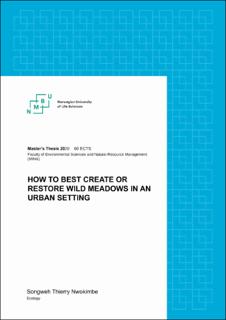| dc.description.abstract | Anthropogenic activities associated with increasing influx of people in cities globally and the capital city of Norway, Oslo, has expansively fragment and decreased urban green space, reducing the connectivity between the remaining remnant green patches. Consequently, this contributes to decreasing the biodiversity and increasing the spread of invasive species in Oslo and cities worldwide. Oslo has begun the establishment of native meadow patches on and off green roofs as steppingstone to mitigate anthropogenic encroachment in Oslo, and hence, improve biodiversity in the city. However, native meadow assemblages on small patches, such as roofs are affected by multiple negative factors, for instance, extreme environmental conditions and production of high volumes of minerals, which causes intensive drought conditions. To mitigate these effects and minimise the creation of ecological traps and sinks, we conducted an experimental field test to investigate methods for creating native meadows on green roofs in an urban setting (case study; Oslo city Norway). An exact number of native meadow plant seeds was sown in various plots, the effect of three different soil treatments (100% topsoil(organic soil from Oslo compost), 50% topsoil and 50% sand, 95% topsoil and 5% silt), and two substrate depths (18 cm and 30 cm) were tested, on the sprouting success and biomass of sown meadow species, colonizers, and sprouting number of invasive species. The sprouts and biomass of sown species appeared higher for 30 versus 18 cm for all soil types, but the pattern was not statically significant. Averagely, topsoil and 30 cm depth had the highest number of sprouts and dry weight of sown species and topsoil mixed with sand and 18 cm depth had the lowest number of sprouts and dry weight. Colonizing species (those that appeared but we did not sow in ourselves) exhibited a significantly lower number of sprouts in 30 versus 18 cm for all soil types, with highest in topsoil and lowest in topsoil mixed with silt. The biomass of colonizing species revealed similar results with highest in 18 cm substrate depth of topsoil and lowest in 30 cm depth of topsoil mixed with sand. The number of sprouts of invasive species appeared to be higher in 30 compared to 18 cm for topsoil and topsoil mixed with silt and decreased in 30 versus 18 cm for topsoil mixed with sand, though the patterns were not statically significant. The biomass of invasive species showed a higher amount in 30 compared to 18 cm, but lower for topsoil mixed with sand and the patterns was also not statically significant. There was no statistically significant interaction between substrate depth and soil treatments on the sprout and biomass of all meadow species. Meaning that both substrate depth and soil treatment influenced the sprouts and biomass of these species in our experiment independently. These results indicate that soil quality was the main driver for the total number of sprouts and biomass combined for all species registered in this field experiment. Meanwhile, substrate depth has little role to play in determining the number of sprouts and biomass of sown meadow species and invasive species yet influenced the colonization of our site. Additional factors such as surrounding green space, shading from trees, seed banks, phenological differences between species, seed dispersal by birds, insects, and wind, could be potential sources of colonization, influencing sprouting, growth, and ultimately, gene flow and genetic rescue in our experiment. | en_US |

